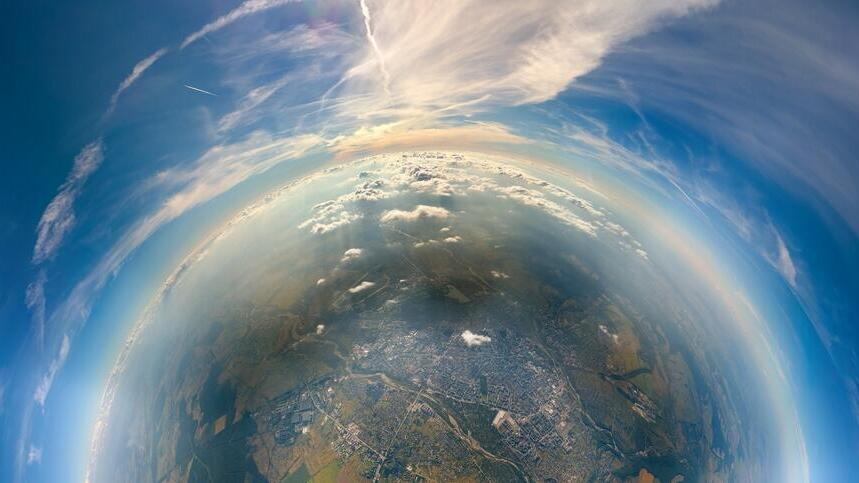Let's take a moment to talk about air. Most of the time, we're completely unaware of its presence, yet it's always around us, filling our lungs and constantly exerting pressure on our organs. Scientifically, air is the collection of gasses surrounding us in the Earth’s environment. This gaseous envelope is known as the Earth’s atmosphere, and its unique composition is different from that of other planets with atmospheres in our Solar System.
Where does the atmosphere come from? The answer lies in the same force that, according to legend, caused the apple to fall on Isaac Newton’s head - the force of gravity. Earth's mass creates a gravitational field that attracts all objects around it. This applies to all matter with mass, from the solid rocks beneath us, to the oceans of liquid water, and finally to the atmosphere, which is by and large in a gaseous state.
The gas composition
Most of Earth's atmosphere—around 78 percent of all the gasses—is nitrogen. Nitrogen, the seventh element in the periodic table, is tasteless, odorless, colorless, and relatively non-reactive. The second most abundant gas, making up about 21 percent of the atmosphere, is oxygen.
Humans, along with most living organisms on Earth, rely on oxygen for energy production; without it, complex life as we know it would be impossible. That’s why, when astronomers search for signs of life on other planets, the "smoking gun" is usually the proportion of oxygen in their atmosphere or the presence of water, which also contains oxygen.
The combined concentration of the rest of the gasses in the atmosphere being re-emitted into space to just one percent, and comprises mainly the noble gas, argon. Another notable gas is carbon dioxide, which, despite its low concentration—around just 0.04%—has a significant impact on our world.
Its importance lies in being the primary greenhouse gas in the atmosphere. Greenhouse gasses are molecules that trap the solar radiation that reaches Earth’s surface, preventing it from being re-emitted into space. Without them, the average temperature on Earth would be about 30 degrees Celsius cooler, and it’s unclear whether and how life could exist here in such a case.
Greenhouse gasses, therefore, are important for life; the problem is that since the Industrial Revolution humanity has been emitting greenhouse gasses at an increasing rate, and as a result the Earth is warming even more. Consequently, the world’s climate is changing, and disasters such as floods, storms and droughts, are becoming more common.
Another critical component of the atmosphere is water. Water exists in the air as gas (vapor), liquid (such as droplets in clouds), and even solid (ice crystals in some clouds). The concentration of water in the atmosphere, known as humidity, varies depending on location and season. In the lower layers of the atmosphere, water vapor is almost always present, with its concentration sometimes reaching up to forty percent.
Layers upon layers
Humidity teaches us an important fact about the atmosphere—it is not necessarily uniform. For example, near hot water sources the concentration of water vapor tends to be high. Another property of the atmosphere is that it becomes thinner and thinner at higher altitude, thus on high mountains, where the air is thin, breathing can be difficult and one may suffer from altitude sickness.
The atmosphere is commonly divided into several layers. The lowest layer, in which we and all other living organisms exist, is the troposphere. This layer holds 75–80 percent of the atmosphere's air and extends up to about seven kilometers at the poles and 17 kilometers near the equator.
As altitude increases, the temperature drops, leading to frigid conditions on high mountain peaks, with rapidly changing weather that can shift within hours. Most of the atmosphere's humidity is concentrated in the troposphere, primarily in the form of clouds and precipitation
Above the troposphere, up to a height of about 50 kilometers, lies the stratosphere. The stratosphere includes the ozone layer, which absorbs most of the solar radiation in the ultraviolet range, which is dangerous for us.
Thus, the temperature in the stratosphere actually increases as you ascend. This phenomenon, known as inversion, stabilizes the stratosphere, meaning it slows down the rate of change within it. This property may have far-reaching consequences during volcanic eruptions, for example. When the ash from an eruption remains in the troposphere alone, its impact remains short-term and transient. In contrast, when volcanic ash reaches the stratosphere its impact on the climate may last for many years.
Above the stratosphere are three additional layers: the mesosphere, the thermosphere and the exosphere. In terms of mass, these layers are negligible compared to the troposphere and stratosphere, as the total amount of gas in them makes up only about one percent of the atmosphere's entire mass.
Nevertheless, they play an important role in filtering harmful radiation at wavelengths shorter than ultraviolet light (thermosphere) and preventing entry of meteors that would otherwise strike Earth (mesosphere).
We don’t usually give much thought to the air around us, but its importance is undeniable. The five layers of the atmosphere not only shield us from extreme temperatures, radiation, and meteorites, but they also provide the foundation for our existence—air to breathe, in every sense of the word. Each and every layer plays a critical role in the complex system that protects us and all life on our planet.
Get the Ynetnews app on your smartphone:




